Overview of Linux Memory Management Concepts: Slabs
Jim Blakey
Note: In the Linux 2.6 kernels, a new cache
manager called the slub allocator is available and may replace the
slab allocator described here. Either can be used through kernel
configuration parameters. This paper was written a while ago and does
not contain the most current kernel information. I will write an
update soon - jimb
Introduction to slabs and kernel cache
Kernel modules and drivers often need to allocate
temporary storage for non-persistent structures and objects, such
as inodes, task structures, and device structures. These objects
are uniform in size and are allocated and released many
times during the life of the kernel. In earlier Unix and Linux
implementations, the usual mechanisms for creating
and releasing these objects were the kmalloc()
and kfree() kernel calls.
However, these used an allocation scheme that was optimized
for allocating and releasing pages in multiples of the hardware page
size. For the small transient objects often required by the kernel and
drivers, these page allocation routines were horribly inefficient, leaving
the individual kernel modules and drivers responsible for optimizing
their own memory usage.
One solution was to create a global kernel caching allocator
which manages individual caches of identical objects on behalf of
kernel modules and drivers. Each module or driver can ask the kernel
cache allocator to create a private cache of a specific object type.
The cache allocator handles growing each cache as needed on behalf of
the module, and more importantly, the cache allocator can release unused
pages back to the free pool in times when memory is in a crunch. The
cache allocator works with the rest of the memory system to maintain a balance
between the memory needs of each driver or module and the system as a whole.
The Linux 2.4 kernel implements a caching memory allocator
to hold caches (called slabs) of identical
objects. This slab allocator is basically an implementation of the
"Slab Allocator" as described in UNIX Internals: The New Frontiers
by Uresh Vahalia, Prentice Hall, ISBN 0-13-101908-2,
with further tweaks based on a The Slab Allocator: An
Object-Caching Kernel Memory Allocator, Jeff Bonwick (Sun
Microsystems). presented at: USENIX Summer 1994
Technical Conference.
The following is a partial list of caches maintained by the Slab
Allocator on a typical Linux 2.4 system. This information comes from the
/proc/slabinfo file. Note that most kernel modules have requested
their own caches. The columns are cache name, active objects, total
number of objects, object size, number of full or partial pages,
total allocated pages, and pages per slab.
slabinfo - version: 1.1
kmem_cache 59 78 100 2 2 1
ip_fib_hash 10 113 32 1 1 1
ip_conntrack 0 0 384 0 0 1
urb_priv 0 0 64 0 0 1
clip_arp_cache 0 0 128 0 0 1
ip_mrt_cache 0 0 96 0 0 1
tcp_tw_bucket 0 30 128 0 1 1
tcp_bind_bucket 5 113 32 1 1 1
tcp_open_request 0 0 96 0 0 1
inet_peer_cache 0 0 64 0 0 1
ip_dst_cache 23 100 192 5 5 1
arp_cache 2 30 128 1 1 1
blkdev_requests 256 520 96 7 13 1
dnotify cache 0 0 20 0 0 1
file lock cache 2 42 92 1 1 1
fasync cache 1 202 16 1 1 1
uid_cache 4 113 32 1 1 1
skbuff_head_cache 93 96 160 4 4 1
sock 115 126 1280 40 42 1
sigqueue 0 29 132 0 1 1
cdev_cache 156 177 64 3 3 1
bdev_cache 69 118 64 2 2 1
mnt_cache 13 40 96 1 1 1
inode_cache 5561 5580 416 619 620 1
dentry_cache 7599 7620 128 254 254 1
dquot 0 0 128 0 0 1
filp 1249 1280 96 32 32 1
names_cache 0 8 4096 0 8 1
buffer_head 15303 16920 96 422 423 1
mm_struct 47 72 160 2 3 1
vm_area_struct 1954 2183 64 34 37 1
fs_cache 46 59 64 1 1 1
files_cache 46 54 416 6 6 1
<snip>
|
Figure 1: Typical list of caches maintained by kernel
Slab Overview
A slab is a set of one or more contiguous pages of memory
set aside by the slab allocator for an individual cache. This memory
is further divided into equal segments the size of the object type
that the cache is managing.
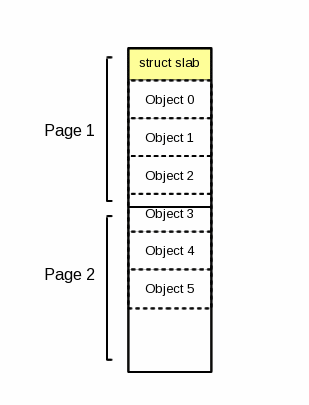
Figure 2: Two page slab with 6 objects
As an example, assume a file-system driver wishes to create
a cache of inodes that it can pull from. Through
the kmem_cache_create() call, the slab allocator
will calculate the optimal number of pages (in powers of 2) required
for each slab given the inode size and other parameters. A
kmem_cache_t pointer to this new inode cache is
returned to the file-system driver.
When the file-system driver needs a new inode, it calls
kmem_cache_alloc() with the kmem_cache_t
pointer. The slab allocator will attempt to find a free
inode object within the slabs currently allocated to that cache.
If there are no free objects, or no slabs, then the slab allocator will
grow the cache by fetching a new slab from the free page memory and returning
an inode object from that.
When the file-system driver is finished with the inode object,
it calls kmem_cache_free() to release the inode.
The slab allocator will then mark that object within the slab as
free and available.
If all objects within a slab are free, the pages that make up the slab are
available to be returned to the free page pool if memory becomes tight.
If more inodes are required at a later time, the slab allocator will
re-grow the cache by fetching more slabs from free page memory. All of
this is completely transparent to the file-system driver.
Creation and management of slab pages
Each slab of pages has an associated slab management structure. The
slab_t struct is defined in /usr/src/linux/mm/slab.c has the following
format:
typedef struct slab_s {
struct list_head list;
unsigned long colouroff;
void *s_mem; /* including colour offset */
unsigned int inuse; /* num of objs active in slab */
kmem_bufctl_t free;
} slab_t;
Where:
list is a generic linked list structure found in
/usr/include/linux/list.h. This type of list structure is used
through out the Linux kernel. It contains a prev
and next which are used to track of where this
slab is being used. The various lists the slab_t can
be on is described in the next section.
colouroff is an offset within the slab where the
slab_t and allocated objects begin. This is part of the
cache coloring described a little later.
s_mem is a pointer to the first object in the slab.
The cache objects are contiguous from this point. Any object in
the slab can be referenced by (object number * object size)
+ s_mem
inuse is a counter of the number of objects currently
in use.
free is an integer index of the current next free
object within the slab.
|
The slab_t structure is immediately followed by an array of
kmem_bufctl_ts. There is one of these for for each object in the
slab. The purpose of the kmem_bufctl_t array is to keep track of
allocated and free objects within the slab. Implementations of slab
allocators often have these structs containing forward/backward pointers,
reference counts, pointers to the slabs they're in, etc. However,
the Linux 2.4 implementation of virtual memory uses the
page struct to keep track of which caches and slabs
cache objects belong to, so the kmem_bufctl_t can be very
simple. In fact, it is a single integer index. This array, along with the
slab_t>-free member in effect implement the cache heap.
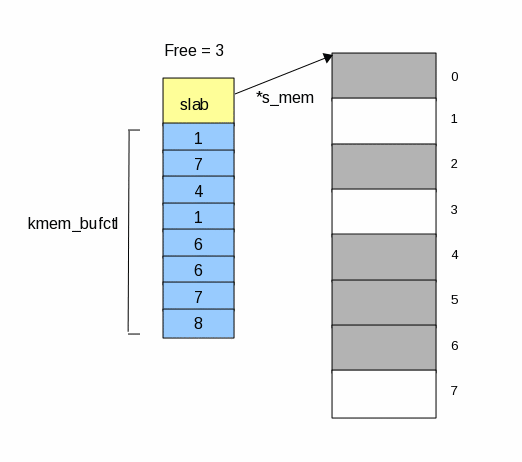
Figure 3. Off slab slab_t structure with 8 kmem_bufctl_t structs
The above figure shows the bufctl in use after several
slab objects have been allocated and deleted. The next free
object to be allocated will be in slot 3. Then free will
assume the value in slot 3's bufctl or the value 1. So
slot 1 will get the following next object allocated. Etc.
A slab_t structure may reside in the slab it describes
or it may be allocated as part of the kmem_cache cache, depending on
the size of the objects in the slab. Figure 2 shows an on-slab
slab_t structure, where figure 3 shows on off-slab
slab_t. The assumption is that if the objects in the
cache are large, it is better to place the slab_t off-slab
for less fragmentation and better packing of the objects. The rule is if
the object size is greater than 1/8th the page size, the slab_t
is allocated off-slab
The number of objects per slab (and therefore the number of
pages per slab) is calculated when the cache is initially created.
The driver or kernel module that asks for the cache only supplies the
size of the objects to be cached, and should never have to care
about how many objects there are in the cache.
The basic algorithm for calculating the number of objects in a slab
is: First see how many objects fit on one page. If the left over is
less than 1/8th the total slab size, then the fragmentation (or wastage)
is acceptable and we're done.
If there is too much left over empty space on the first try,
we try again with a larger slab. Slabs are grown in multiples of
powers of 2 of the page size (kept internally as gfporder).
So the first try, gfporder is 0 for 1 page, second try
gfporder is 1 for 2 pages, next try gets 4 pages, next gets 8
pages, etc.
The actual algorithm used is obviously a little more complex than
what I've just described. There are a lot of other factors and limits
to take into account, such as whether the slab_t is kept
on the slab (so its size figures into the equation), cache coloring,
L1 cache alignment of the objects to reduce cache hits, etc. But the
general idea is to find a balance of the number of pages in the slab
and the number of objects in the slab for most efficient use of the
space available.
The cache
A cache is a group of one or more slabs of object type. The
structure that maintains each cache is the kmem_cache_t. The
following is a partial list of important fields within the
kmem_cache_t structure. This is not a complete structure, as
all SMP and statistics related fields were removed for brevity. The
full structure is defined in /usr/src/linux/mm/slab.c.
struct kmem_cache_s {
struct list_head slabs_full;
struct list_head slabs_partial;
struct list_head slabs_free;
unsigned int objsize;
unsigned int flags; /* constant flags */
unsigned int num; /* # of objs per slab */
spinlock_t spinlock;
...
unsigned int gfporder;
unsigned int gfpflags;
size_t colour; /* cache colouring range */
unsigned int colour_off; /* colour offset */
unsigned int colour_next; /* cache colouring */
...
kmem_cache_t *slabp_cache;
unsigned int growing;
...
void (*ctor)(void *, kmem_cache_t *, unsigned long);
void (*dtor)(void *, kmem_cache_t *, unsigned long);
char name[CACHE_NAMELEN];
struct list_head next;
...
};
Where:
Where:
slabs_full, slabs_partial,and slabs_free
are lists of slabs associated with this cache.
objsize is the size of the objects contained within
the cache.
num is the number of cache objects per slab. This
is calculated when the cache is created as a function of the size
of each object and the best fit for a given number of memory
pages per slab.
gfporder is the number of pages per slab as a power of
two. For example, for 1 page/slab, gfporder is 0, for 2 pages/slab,
gfporder is 1, for 4 pages, 2, for 8 pages, 3, etc... Pages are
always allocated in multiples of powers of two.
colour, colour_off and colour_next are used
to maintain the cache coloring offset for each slab. This will
be discussed later.
*slabp_cache is a pointer to the kernel cache that
is used for the slab_t, if the slab_t
is maintained off-slab.
growing is a flag that the cache is growing so that
the memory pages won't be de-allocated.
ctor and dtor are driver callback routines.
These are constructor and destructor routines that the driver
can supply that will be called when an object is allocated or
released. This allows a driver to have a custom initialization
or validation routine on object allocation, or to perform any
cleanup before an object is released. These are also very useful
for driver debugging.
name is a string describing the cache. This will be
printed as part of the /proc/slabinfo file. See Slab Figure 1.
next is a list_struct pointer to the next cache in
the kernel cache chain.
|
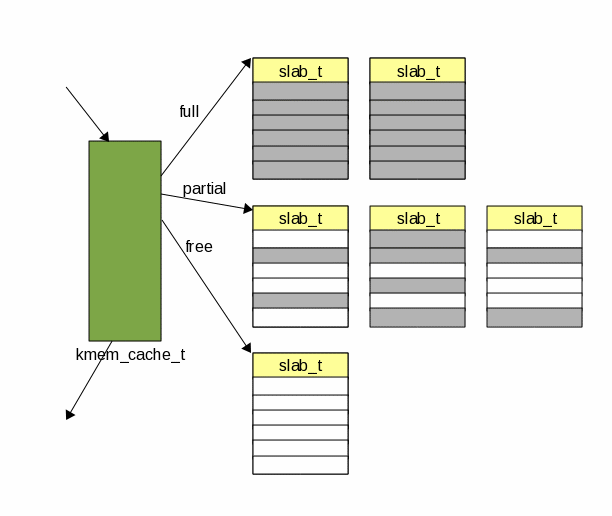
Figure 4. kmem_cache_t and its associated slabs
TODO: Add a couple of paragraphs describing use here
Cache Coloring of Slabs
Cache Coloring is a method to ensure that access to the slabs in
kernel memory make the best use of the processor L1 cache. This is
a performance tweak to try to ensure that we take as few cache hits as
possible. Since slabs begin on page boundaries, it is likely that the
objects within several different slab pages map to the same cache line,
called 'false sharing'. This leads to less than optimal hardware cache
performance. By offsetting each beginning of the first object within each
slab by some fragment of the hardware cache line size, processor cache hits
are reduced.
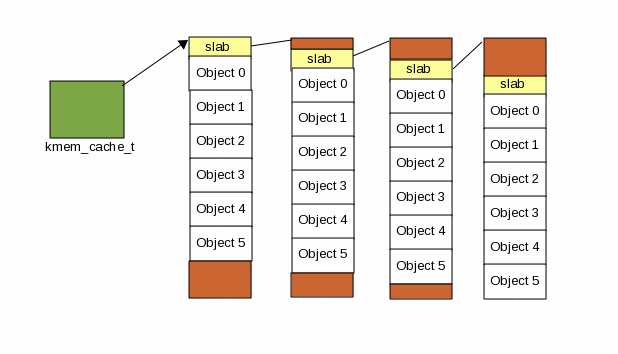
Figure 5. Cache Coloring within slabs
The kmalloc() Interface
Of course, there are times when a kernel module or driver needs to
allocate memory for an object that doesn't fit one of the uniform types
of the other caches, for example string buffers, one-off structures,
temporary storage, etc. For those instances drivers and kernel modules
use the kmalloc() and kfree()
routines. The Linux kernel ties these calls into the slab allocator
too.
On initialization, the kernel asks the slab allocator to create
several caches of varying sizes for this purpose. Caches for generic
objects of 32, 64, 128, 256, all the way to 131072 bytes are created
for both the GFP_NORMAL and GFP_DMA zones of memory.
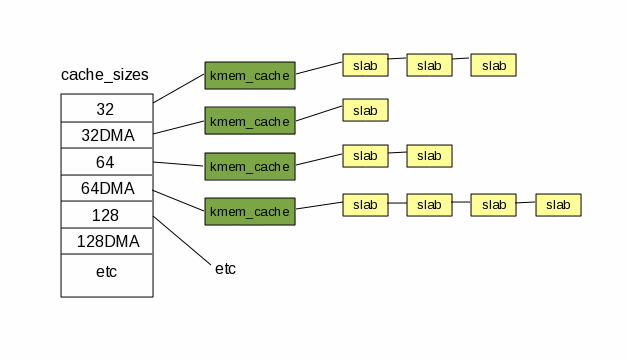
Figure 6: Use of the cache_sizes array
When a kernel module or driver needs memory, the
cache_sizes array is searched to find the cache
with the size appropriate to fit the requested object. For example, if
a driver requests 166 bytes of GFP_NORMAL memory through
kmalloc(), an object from the 256 byte cache would be
returned.
When kfree() is called to release the object,
the page the object resides in is calculated. Then the page
struct for that page is referenced from mem_map
(which was set up to point to our kmem_cache_t
and slab_t pointers when the slab was
allocated). Since we now have the slab and cache for the object, we
an release it with __kmem_cache_free().
TODO: Add a summary paragraph here
| 




